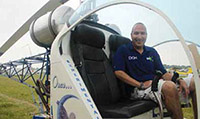
The More Things Change....

…the more they stay the same. As you have likely noticed, we have a new name — Helicopter Maintenance.
We feel it is time to introduce a new name for the magazine that clearly identifies who we are.
When we launched this magazine almost three years ago, we thought of the name HeliMx to represent the two words — Helicopter and Maintenance. Although the name caught on, there was still a bit of confusion on what the name meant –— especially for non-helicopter maintenance types. People would sometimes pick up a copy for the first time and ask, “What’s heli-mix?” Or they would ask us, “Is this a magazine for Mexican helicopter operators?”
Well, we feel it is time to change the name to reflect what our intent was to begin with — the fact that the magazine is all about helicopter maintenance.
In conjunction to our name change, our website address is changing to www.HelicopterMaintenanceMagazine.com. Don’t fret — if you like using www.HeliMx.com it will still take you to our website.
In addition to our name change and address change, here is a list of everything else we are changing with the magazine:
• Nothing
That’s right — we may have changed the name, but our editorial focus remains the same. We are still the ONLY magazine dedicated to helicopter maintenance. Fred Polak is still our editor, and continues to work with our editorial advisory board to publish articles that are relevant to helicopter mechanics.
On a final note, I would like to introduce two additional Helicopter Maintenance editorial advisory board members. The first is Terry Peed. Peed started his aviation career 44 years ago when he joined the Navy and was trained as a jet engine mechanic, assigned to maintain F-8 Cruisaders and F-4 Phantoms. He worked in the power plant shop and as a flight deck trouble-shooter on the USS Hancock during its 1972- 1975 WestPac cruises. Leaving the Navy in 1978, Peed worked for NASA at Edwards AFB in California where he supported various aircraft during the early shuttle days, and spent some time working on experimental aircraft. After about 2 ½ years at NASA, Peed went to work for the US Army as a civilian helicopter mechanic/crew chief maintaining UH-1, OH-6, OH58, AH-1, AH-64 and CH-47 helicopters for the US Army’s Aviation Engineering Flight Activity at Edwards AFB.
Peed left California in 1989 for Wisconsin where he went to work for Omniflight Helicopters in Janesville, WI. Peed would eventually collaborate with Jim Freeman to start Helicopter Specialties in 2000, a helicopter repair station in Janesville, WI, assuming the position of chief inspector (that he occupies to this day). Part of his job then was obtaining FAA Certification as a Part 145 Repair Station.
Peed holds A&P with inspection authorization and received an Associate of Science Degree from Embry-Riddle University Extension Classes in 1999.
The second addition to the board is Del Richardson. Richardson is the director of maintenance for the Fairfax County Police Department, helicopter division, located in Northern Virginia. The department has two new Bell 429’s — the first in the world with a dual roll of law enforcement and EMS. In alignment with the position of DOM, Richardson been an aviation mechanic for over 25 years, He has been an A&P for 20 years, is an IA, and is a certified NTSB crash investigator for fixed wing and rotorcraft. Richardson graduated from helicopter pilot training in 2006 having earned a commercial rotorcraft rating, instrument rating, along with a rotorcraft certified flight instructor instrument rating. He currently has around 2,500 rotorcraft hours.
Richardson is considered an expert in the field of composites and composite structures beginning in the “black world” with General Electric Engines in Mojave, CA. He worked on many projects such as the B2 Bomber, 117-stealth fighter, GE90 commercial engine, and many design and development projects. Richardson worked with Rockwell International on the B-1 Bomber as a structures and flight line mechanic. He was also employed with McDonnell Douglas working on many commercial aircraft. He worked with Burt Rutan on many new design and development projects at Scaled Composites where he was also the crew chief on the Ares demonstration fighter. Richardson then moved into being the owner of his own composite company. In this capacity, he provided professional, expert composite work and consultation to the public and various government ranks.
We welcome Peed and Richardson, and thank them and the rest of the editorial advisory board for helping to steer the quality editorial you have come to expect.
 Thanks for reading!
Thanks for reading!
Joe Escobar | Editorial Director
